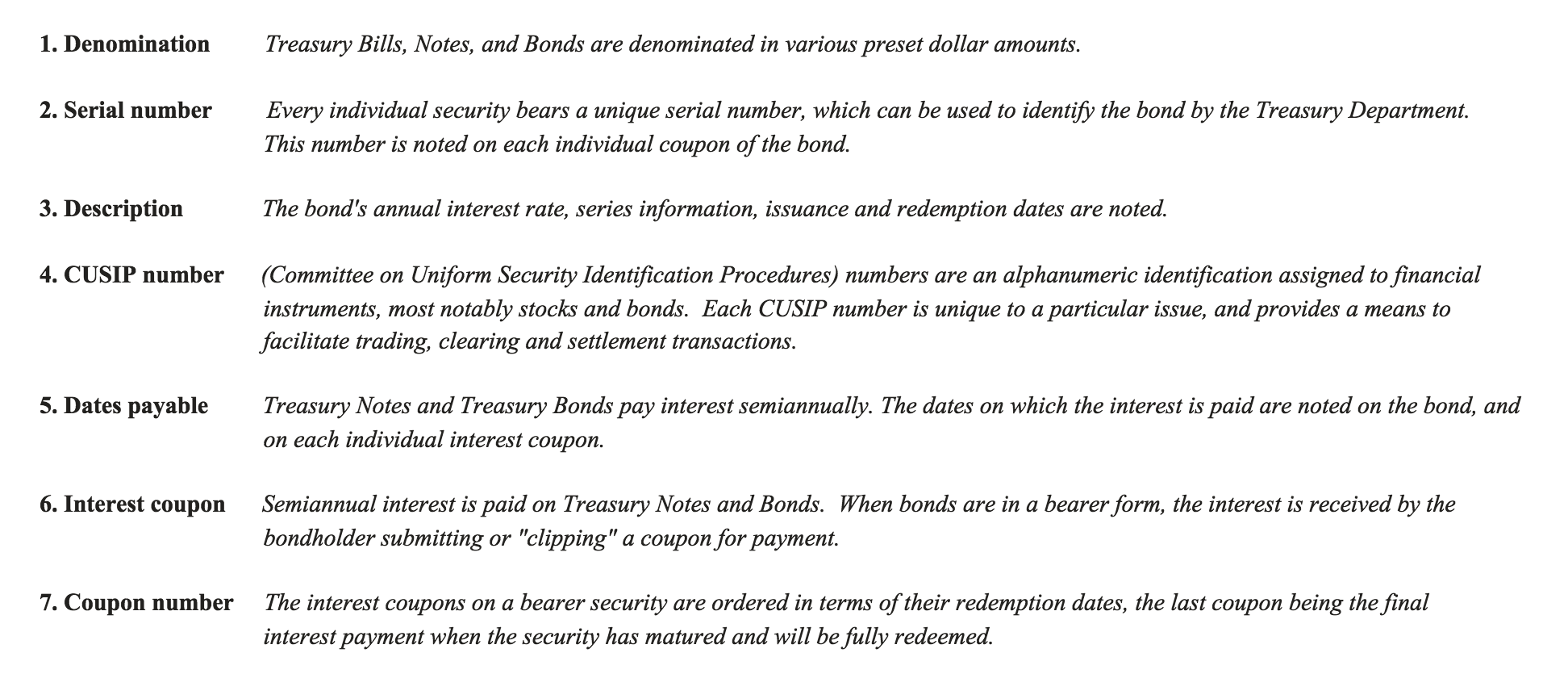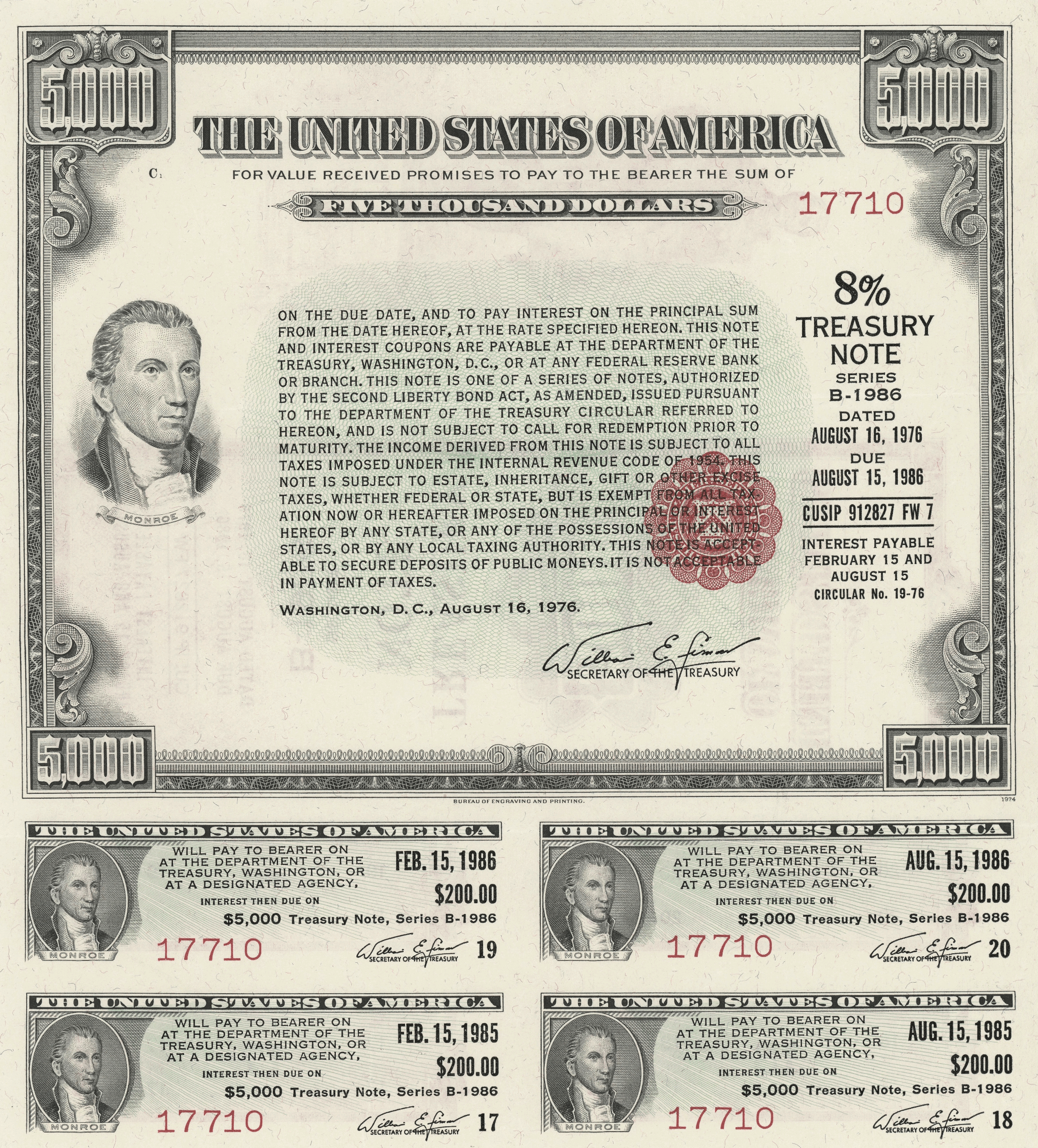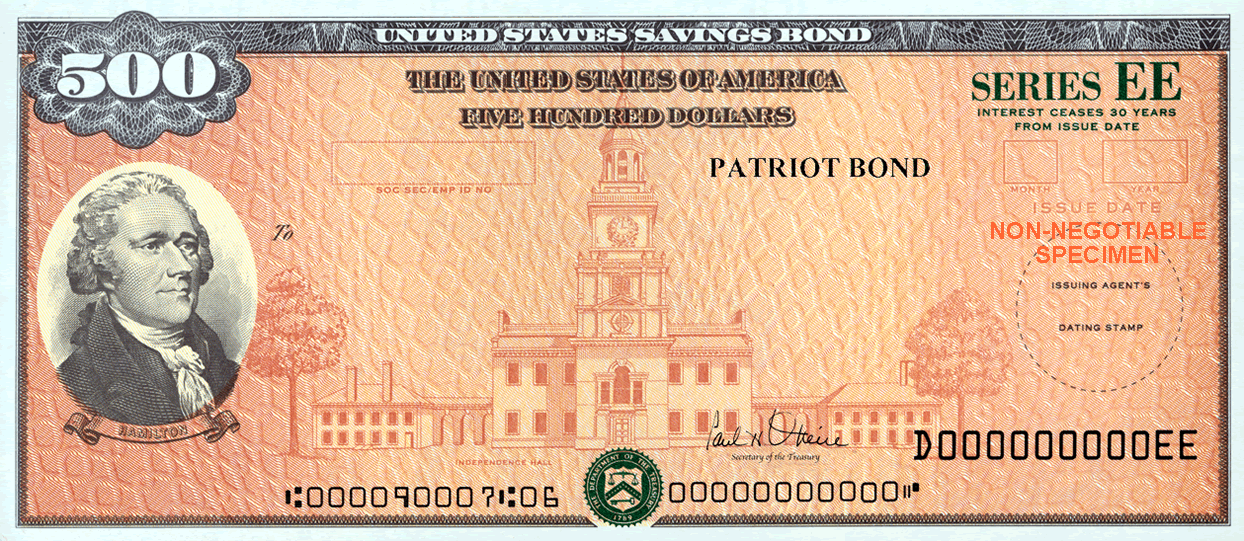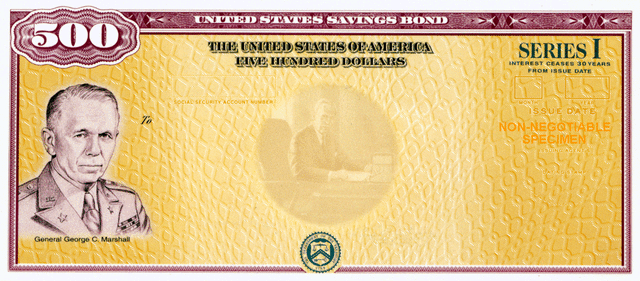
AN INTRODUCTION TO GOVERNMENT BONDS
A bond is simply a loan- a promise to pay back borrowed money at a specified future date, with interest rate payment(s) as compensation to the lender. Since 1776, the United States has needed a means of raising funds to pay for its government's operation. While taxes and tariffs have been able to fund a portion of these expenses, America has issued various debt instruments throughout her history. This debt has been in the form of bonds, bills, and notes, issued by the U.S. Treasury Department. Colloquially, they are known as Treasury bonds, Treasury securities, or simply Treasuries. The difference between a Treasury Bill, a Treasury Note, and a Treasury Bond is the length of maturity of the debt- the time the government has to pay back the lender.
In addition to these marketable securities, the U.S. Treasury issued several types of non-marketable debt instruments. They have included Adjusted Service Bonds, (issued to veterans of WWI), Armed Forces Leave Bonds, (servicemen of WWII), and Postal Savings Bonds, the forefather of the U.S. Savings Bond. Most notably the Treasury issues non-marketable debt via the U.S. Savings Bond program, which began in 1935 under FDR.
What are Treasury Bills, Notes, and Bonds?

1933 $500 Treasury Bond
The Joe I. Herbstman Memorial Collection
The national debt of the United States is the accumulated amount of money America owes to all of its creditors. These creditors are bondholders: ranging from individual American citizens to large banks, investment funds, foreign individuals, corporations, and governments. The United States even owes itself. The U.S. Government has on its balance sheet a line item for intragovernmental holdings: debt issued against money borrowed from various federal trust funds used to fund current government expenditures. The U.S. national debt stands currently at over $22 trillion dollars, with about $6 trillion of that being intragovernmental holdings.
What is the National Debt?
What is the Budget Defecit?
The deficit is the annual difference between what the Federal Government takes in, (revenues from taxes, fees, etc.), and what the government must spend (outlays). As the U.S. has not had a history of balancing its receipts and expenditures, deficits have continued to grow the U.S. national debt. As a fiscal year ends, the total amount of debt grows by the deficit or shortfall in the nation's budget. The national debt could be reduced were the U.S. to have a surplus in revenues in any particular year. In 1835, under President Andrew Jackson, the United States paid off entirely the national debt, which at the time was about $58 million. This is the only time in history the Unites States retired its entire national debt, and it lasted all of one year.
Treasury Securities In-Depth
To better understand Treasuries, it is helpful to examine the various parts of a bond. Below are two examples of Treasury securities. The first is a medium-term debt instrument known as a Treasury Note. This security is in bearer form, meaning ownership is presumed simply through possession. The second is a long-term debt obligation, known as a Treasury Bond. It is in a registered format, meaning that the proof of ownership is both on the security as well as it being recorded within the Treasury Department.


The Different Types of Treasuries
Treasury securities are issued in several different formats. Presented here is a brief history and explanation of the different securities the Treasury Department has offered throughout its history, along with examples of various types of Treasury Bonds.
Part I. Marketable Securities
A marketable security is one that is transferable through purchase. The original owner may choose to sell his/her bond long before its date of maturity. As shown above, marketable Treasuries could be either in registered or bearer format. Today however, almost all U.S. Treasury bonds are in a book-entry system, meaning there is only an electronic record of the debt. There are no longer any bearer bonds earning interest (although some remain outstanding), and there is some $30 million in registered Treasury Bonds that will be maturing in the coming few years. Marketable Treasuries are basically divided into three distinct categories: Treasury Bills, Treasury Notes, and Treasury Bonds.
Treasury Bills
Treasury Bills, often referred to as T-Bills, are the shortest term debt instrument issued by the Treasury Department. Issued with maturity dates ranging from days up to one year, they are issued at a discount, and pay no interest. They are redeemed at par value (100 cents to the dollar). T-Bills were never issued in a registered format, given the impracticality of re-registering bonds that had short maturity periods. Today, they are issued in electronic format only. They are primarily held and traded by banks, brokerages, and other large financial institutions, although individuals can and do purchase them. They are sold by the Treasury Department through an auction process.
%20copy.jpg)
1969 $100,000 Treasury Bill
The Joe I. Herbstman Memorial Collection
Treasury Notes
Treasury Notes, often referred to as T-Notes, are a medium term debt instrument issued by the Treasury Department. Issued with maturity dates ranging from two to ten years. They pay a fixed rate of interest semiannually. Treasury Notes were issued for many years both as registered and bearer securities. Today, they are issued in electronic format only. They are sold by the Treasury Department through both competitive and non-competitive auctions. The yield on the ten-year Treasury Note has an important relationship with mortgage interest rates in the United States. This is in part due to the nature of how mortgage securities are traded within the financial community. The interest paid on Treasury Notes, (along with Treasury Bills and Treasury Bonds), is exempt from both state and local income taxation.

1976 $5,000 Treasury Note
The Joe I. Herbstman Memorial Collection
Treasury Bonds
Treasury Bonds, often referred to as T-Bonds, are a long-term debt instrument issued by the Treasury Department. Issued with maturity dates ranging from ten years to thirty years, although longer maturities have been issued. They pay a fixed rate of interest semiannually. Treasury Bonds were issued for many years both as registered and bearer securities. Today, they are issued in electronic format only. They are issued by the Treasury through both competitive and non-competitive auctions. A competitive auction is where bidders place bids on the rate of the bond to be issued. A participant therefore is not guaranteed to receive bonds. A non-competitive auction ensures the a bidder will receive bonds, however the interest rate will be set beforehand.
.png)
1981 $1000 Treasury Bond
The Joe I. Herbstman Memorial Collection
Part II. Non-Marketable Securities
The Treasury Department issues debt that is categorized as non-marketable securities. These bonds are not exchangeable between parties once issued, and can only be redeemed by the owner of record or, in the case of death, their estate. The most well known examples are U.S. Savings Bonds. The Savings Bond Program is (and always has been) comprised solely of non-marketable securities.
Adjusted Service Bonds were issued to veterans of WWI. They were the successor payments to the World War Adjusted Compensation Act, which provided a bonus payment to soldiers based on the number of days served in the war. These certificates could not be redeemed until 1945, causing financial hardship for many veterans. After a protest in the summer of 1932, known as the "Bonus Army," Congress eventually changed the law in 1936 and paid the veterans upon redemption of the older certificates. The Adjusted Service Bonds were issued to replace the prior debt, and were payable by the Treasury any time after June of 1936.

$50 Adjusted Service Bond
The Joe I. Herbstman Memorial Collection

Armed Forces Leave Bonds were issued to veterans of WWII. Issued in increments of $25, these registered bonds were given to veterans the first day of the financial quarter following their discharge date. They bore a 2.5% interest rate for five years, and were payable immediately upon death. Over $2 billion were issued to the veterans of the war.
Armed Forces Leave Bond
The Joe I Herbstman Memorial Collection
U.S. Savings Bonds are the easiest type of historic bond to find in the collector marketplace. There is approximately $16 billion in unredeemed Savings Bonds, compared with $95 million in unredeemed bearer securities. Shown here is a WWII Savings Bond, often referred to as a war bond or defense bond. It was issued in the amount of $10,000. The purchaser however would have paid less than the face value.
Savings Bonds do not pay out a semi-annual interest check. The interest is paid when the bond is turned in for redemption. This type of bond is referred to as a zero-coupon security. The amount an investor would receive in return was printed on the bond's face, and was based on the length of time the owner of the bond held it. The longer the period, the more money the bond's owner would receive.
The U.S. Savings Bond program began in 1935 during the Roosevelt administration and continues today. The larger certificates of the war bond era gave way to the punch-card (and later paper stock) smaller Savings Bonds most Americans are familiar with today. In an effort to reduce costs, the Treasury Department ended the sale of all paper Savings Bonds beginning in 2012, save one exception. Individuals can request that part of their IRS refund be issued as a paper Savings Bond.

World War II $10,000 Series F Savings Bond
Specimen

$500 Series EE Savings Bond
Specimen
This specimen is a Series EE Savings Bonds. In paper form, EE bonds were sold at half of their face value. Some particular issues could earn interest for up to thirty years. Today, EE bonds are issued electronically, and are sold at face value by the Treasury Department. An individual can purchase a dollar amount from $25 up to $10,000. Series EE bonds are free from state and local income taxes, and are subject to Federal income taxes. Bonds issued from May 2005 onward earn a fixed rate of return.
In addition to the EE bonds, there are a couple other outstanding series within the U.S. Savings Bond program. Series H bonds were lasted issued in December of 1979, and were sold at face value. They were replaced by Series HH bonds, which where issued from 1980 through August of 2004. While subject to Federal income tax, these bonds were exempt from state and local income taxes. They were issued in denominations of $500, $1000, $5000, and $10,000.

$500 Series HH Savings Bond
Specimen

- SPECIMEN -
Series I Savings Bonds have a unique feature in comparison to traditional savings bonds: their return is partially based on the rate of inflation. The interest paid on Series I bonds is a combination of a fixed rate of return as well as an inflation rate, which is calculated from the Consumer Price Index (CPI). Like other savings bonds, interest from Series I bonds is subject to Federal income taxes, and free from state and local income taxes. They are sold today by the Treasury in electronic format.